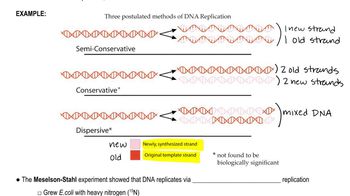Table of contents
- 1. Introduction to Genetics51m
- 2. Mendel's Laws of Inheritance3h 37m
- 3. Extensions to Mendelian Inheritance2h 41m
- 4. Genetic Mapping and Linkage2h 28m
- 5. Genetics of Bacteria and Viruses1h 21m
- 6. Chromosomal Variation1h 48m
- 7. DNA and Chromosome Structure56m
- 8. DNA Replication1h 10m
- 9. Mitosis and Meiosis1h 34m
- 10. Transcription1h 0m
- 11. Translation58m
- 12. Gene Regulation in Prokaryotes1h 19m
- 13. Gene Regulation in Eukaryotes44m
- 14. Genetic Control of Development44m
- 15. Genomes and Genomics1h 50m
- 16. Transposable Elements47m
- 17. Mutation, Repair, and Recombination1h 6m
- 18. Molecular Genetic Tools19m
- 19. Cancer Genetics29m
- 20. Quantitative Genetics1h 26m
- 21. Population Genetics50m
- 22. Evolutionary Genetics29m
8. DNA Replication
Overview of DNA Replication
Problem 3
Textbook Question
Compare conservative, semiconservative, and dispersive modes of DNA replication.
 Verified step by step guidance
Verified step by step guidance1
Understand that DNA replication is the process by which a DNA molecule makes a copy of itself, and there are three proposed models for how this replication could occur: conservative, semiconservative, and dispersive.
In the conservative model, the original DNA molecule remains intact, and an entirely new copy is made. This means after replication, one molecule is the original and the other is completely new.
In the semiconservative model, each of the two strands of the original DNA molecule serves as a template for a new strand. After replication, each DNA molecule consists of one original strand and one new strand.
In the dispersive model, the original DNA molecule is broken into pieces, and new DNA is synthesized in short segments. After replication, each DNA molecule is a mix of old and new DNA segments.
Reflect on the experimental evidence, such as the Meselson-Stahl experiment, which supported the semiconservative model by showing that DNA replication results in molecules with one old and one new strand.
Recommended similar problem, with video answer:
 Verified Solution
Verified SolutionThis video solution was recommended by our tutors as helpful for the problem above
Video duration:
1mPlay a video:
Was this helpful?
Key Concepts
Here are the essential concepts you must grasp in order to answer the question correctly.
Conservative Replication
In conservative replication, the original DNA molecule remains intact, while an entirely new copy is synthesized. This means that after replication, one double helix consists of both original strands, and the other consists of two newly synthesized strands. This model was proposed to explain how genetic information is preserved, but experimental evidence has shown it does not accurately describe DNA replication.
Recommended video:
Guided course

Semiconservative Replication
Semiconservative Replication
Semiconservative replication is the widely accepted model of DNA replication, where each of the two resulting DNA molecules consists of one original strand and one newly synthesized strand. This method ensures that genetic information is accurately passed on during cell division, as each daughter cell receives one strand from the parent DNA and one newly formed strand, maintaining the integrity of the genetic code.
Recommended video:
Guided course

Semiconservative Replication
Dispersive Replication
Dispersive replication suggests that the parental DNA strands are broken into pieces, and both the new and old DNA are interspersed in the daughter molecules. This model implies that the resulting DNA strands would be a mosaic of old and new DNA. However, like conservative replication, this model lacks strong experimental support and is less favored compared to the semiconservative model.
Recommended video:
Guided course

Semiconservative Replication

 5:02m
5:02mWatch next
Master Directionality with a bite sized video explanation from Kylia Goodner
Start learning



